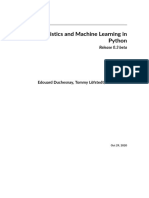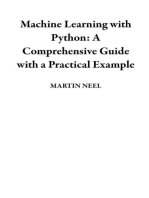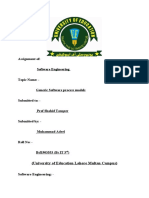Python ML
Uploaded by
Krushna ShindePython ML
Uploaded by
Krushna ShindePYTHON & Machine Learning
Prerequisites
There are no such prerequisites to learn Python but having a basic knowledge of any
programming language concepts like what is a loop, what if and else does, how operators are
used, etc. will be helpful. We recommend Basics of C/C++ will help you to understand the
python and ultimately it will decrease the learning time span of python.
Python for beginner programmers.
Chapter 1. Introduction of Python
• Why Python
• Benefits / features of python
• Role of PVM
• Job openings of python
• Installation of Python Interpreter
• Introduction of IDE – PyCharm
• Download and Installation of PyCharm
Chapter2. Python Work flow
• How to create script
• How to deal with data printing & scanning in Python.
• Package creation
Chapter3. Loops in Python
• For | while | - variation of range()
• Use of Continue ,Pass, Break
Chapter4. Decision Making | Data Validation
• If | if else | if..elif..else
• Conditional Operators | Logical operators in Python
Chapter5. DataTypes in Python : with Builtin Functions
• List
• Tuple
• Set
• Dictionary
• Array
• String
Chapter6. Modular Programming in Python
• Class | Object
• Data migration from One Package to another package
• Functions
• Constructor | destructor
• Main function is Python
PYTHON & Machine Learning
Chapter7. Powerful Lambda function
• Filter | Map | Reduce
Chapter8. File Operations
• File Handling with read/ write Operations using read() | readline() | readlines()
|write()| writelines()
• Event Logs
• File handling with Log files
Chapter9. Regular Expression
• Introduction
• Rules of regular expression
• Pattern searching | Mapping | validation of Data
Chapter10. Exception Handling
• Programming using exception handling technique
• Exception handling with file operations
Chapter11. Database Interaction
• Introduction of database
• Installation of Database
• Basic SQL commands of Database
• Integration of Python and Database using connector
• Python interface with Database using select | Insert | Update | Delete | Join | Drop |
create commands
PYTHON & Machine Learning
Module2: Machine learning for beginner programmers.
Pre-requisites:
• Linear Algebra
• Statistics and Probability
• Calculus
• Graph theory
• Programming Skills – Language such as Python, R, MATLAB.
Data Science Libraries use in algorithm implementation which you will get overview of these
libraries as mentioned below
• Numpy
• Pandas
• Matplotlib
• Seaborn
• Sklearn
• Tensorflow
• Pytorch
Chapter1. Introduction to Machine Learning
• Introduction of Data in machine learning
• Application
• How to understand algorithms.
• Terminologies of Machine learning
• Difference between Machine learning & Artificial Intelligence.
• Introduction Anaconda Navigator | jupyter notebook
• Installation of Anaconda Navigator
Chapter2. Classification of Machine Learning
• Supervised | Unsupervised | Reinforcement | Semi Supervised
Chapter3. Parametric Methods
3.1 Classification Based – KNN algorithm implementation.
3.2 Regression Based algorithm Implementation
• Linear Regression
• Multivariate Linear regression
• Logistic regression
3.3 Introduction of Pytorch
• Installation of Pytorch
• Linear regression using Pytorch
• Difference between Pytorch & Tensorflow
3.4 Introduction of Tensorflow
Installation of tensorflow
PYTHON & Machine Learning
• Linear regression using Tensorflow
• Softmax regression using Tensorflow ( Handwritten Digit Identification)
3.5 Confusion matrix in Machine Learning
Chapter4. Dimensionality Reduction
• Parameters for feature selection
• Overfitting & Under fitting in Machine Learning
Chapter5. Clustering
• Clustering in Machine learning
• Types of clustering algorithm
• Implementation of K- means | Gaussian Mixture Model
Chapter6. Non – Parametric Methods
• Introduction of Decision Tree
• Decision Tree Implementation
• K nearest Neighbor algorithm
Chapter7. Introduction of ANN (Artificial Neutral Network)
• Introduction of Binomial neutral network VS ANN
Chapter8. Hidden Markov Model
• Overview of Hidden Markov process
• Introduction Chinese Room Argument
Chapter9. Data Pre-Processing
• Understanding data processing
• Data cleaning | Data cleansing
You might also like
- Mastering Python for Machine Learning (with Data Science)No ratings yetMastering Python for Machine Learning (with Data Science)3 pages
- PACE 2.0 Syllabus Machine Learning With Python ProgramNo ratings yetPACE 2.0 Syllabus Machine Learning With Python Program18 pages
- Statistics and Machine Learning in PythonNo ratings yetStatistics and Machine Learning in Python218 pages
- Course Curriculum: Internship On PythonNo ratings yetCourse Curriculum: Internship On Python29 pages
- Statistics Machine Learning Python DraftNo ratings yetStatistics Machine Learning Python Draft319 pages
- Python - Follow Dr. AngShu (@drangshu) For More100% (1)Python - Follow Dr. AngShu (@drangshu) For More300 pages
- Statistics and Machine Learning in PythonNo ratings yetStatistics and Machine Learning in Python300 pages
- Mackay Hazel PythoMachine Learning With Pytorch and Scikit Learn A CoNo ratings yetMackay Hazel PythoMachine Learning With Pytorch and Scikit Learn A Co135 pages
- Python Programming: 3 Books in 1: Ultimate Beginneru2019s, Intermediate & Advanced Guide to Learn Python Step-by-Step download100% (2)Python Programming: 3 Books in 1: Ultimate Beginneru2019s, Intermediate & Advanced Guide to Learn Python Step-by-Step download27 pages
- Python Programming: 3 Books in 1: Ultimate Beginneru2019s, Intermediate & Advanced Guide to Learn Python Step-by-Step instant download100% (1)Python Programming: 3 Books in 1: Ultimate Beginneru2019s, Intermediate & Advanced Guide to Learn Python Step-by-Step instant download52 pages
- Machine Learning Engineer Course Curriculum PDFNo ratings yetMachine Learning Engineer Course Curriculum PDF40 pages
- 4 Weeks Machine Learning and Artificial IntelligenceNo ratings yet4 Weeks Machine Learning and Artificial Intelligence3 pages
- Learning Data Mining with Python Layton pdf download100% (2)Learning Data Mining with Python Layton pdf download62 pages
- Python Programming: 3 Books in 1: Ultimate Beginneru2019s, Intermediate & Advanced Guide to Learn Python Step-by-Step - Download the ebook today and own the complete version100% (1)Python Programming: 3 Books in 1: Ultimate Beginneru2019s, Intermediate & Advanced Guide to Learn Python Step-by-Step - Download the ebook today and own the complete version55 pages
- Machine Learning Course Content For Classroomdocx - 240504 - 163403No ratings yetMachine Learning Course Content For Classroomdocx - 240504 - 1634036 pages
- Python - 3 Books in 1 - Beginner's Guide, Data Science and Machine Learning. The Easiest Guide To Start Python Programming. Unlock Your Programmer Potential and Develop Your Project in100% (1)Python - 3 Books in 1 - Beginner's Guide, Data Science and Machine Learning. The Easiest Guide To Start Python Programming. Unlock Your Programmer Potential and Develop Your Project in241 pages
- Master+Data+Science,+Data+Analytics+and+Machine+Learning+Using+Python (1)No ratings yetMaster+Data+Science,+Data+Analytics+and+Machine+Learning+Using+Python (1)16 pages
- How Python Can Be Used Fo.9358036.PowerpointNo ratings yetHow Python Can Be Used Fo.9358036.Powerpoint7 pages
- Data Science & Machine Learning Course (7) (7)No ratings yetData Science & Machine Learning Course (7) (7)1 page
- Data Sciences with Python Machine Learning (2-in-1 course)No ratings yetData Sciences with Python Machine Learning (2-in-1 course)3 pages
- Python for Machine Learning: From Fundamentals to Real-World ApplicationsFrom EverandPython for Machine Learning: From Fundamentals to Real-World ApplicationsNo ratings yet
- Exploring the Python Library Ecosystem: A Comprehensive GuideFrom EverandExploring the Python Library Ecosystem: A Comprehensive GuideNo ratings yet
- Mastering Python Algorithms: Practical Solutions for Complex ProblemsFrom EverandMastering Python Algorithms: Practical Solutions for Complex ProblemsNo ratings yet
- Machine Learning with Python: A Comprehensive Guide with a Practical ExampleFrom EverandMachine Learning with Python: A Comprehensive Guide with a Practical ExampleNo ratings yet
- GPURepair Automated Repair of GPU KernelsNo ratings yetGPURepair Automated Repair of GPU Kernels19 pages
- Visual Studio Code - Code Editing. RedefinedNo ratings yetVisual Studio Code - Code Editing. Redefined9 pages
- Blexr - Full Stack Engineer (React - Next.Node) - 1No ratings yetBlexr - Full Stack Engineer (React - Next.Node) - 14 pages
- JBL - UA Sport Wireless Flash - QSG - MultilingualNo ratings yetJBL - UA Sport Wireless Flash - QSG - Multilingual48 pages
- Assignment of Generic Models (Software Engineering)No ratings yetAssignment of Generic Models (Software Engineering)8 pages
- XtremIO X2 Model Compatibility Matrix v6.2No ratings yetXtremIO X2 Model Compatibility Matrix v6.21 page
- MetroFibre Step by Step Guide for Nokia Customers 1No ratings yetMetroFibre Step by Step Guide for Nokia Customers 19 pages
- CSC - 406 - 1 - Intro To Distributed SystemNo ratings yetCSC - 406 - 1 - Intro To Distributed System22 pages
- DTA-DTB-DTC Default Reset by ComunicationNo ratings yetDTA-DTB-DTC Default Reset by Comunication8 pages
- Testing: Software Verification and Validation Swhat Is Verification?100% (1)Testing: Software Verification and Validation Swhat Is Verification?24 pages

























































































